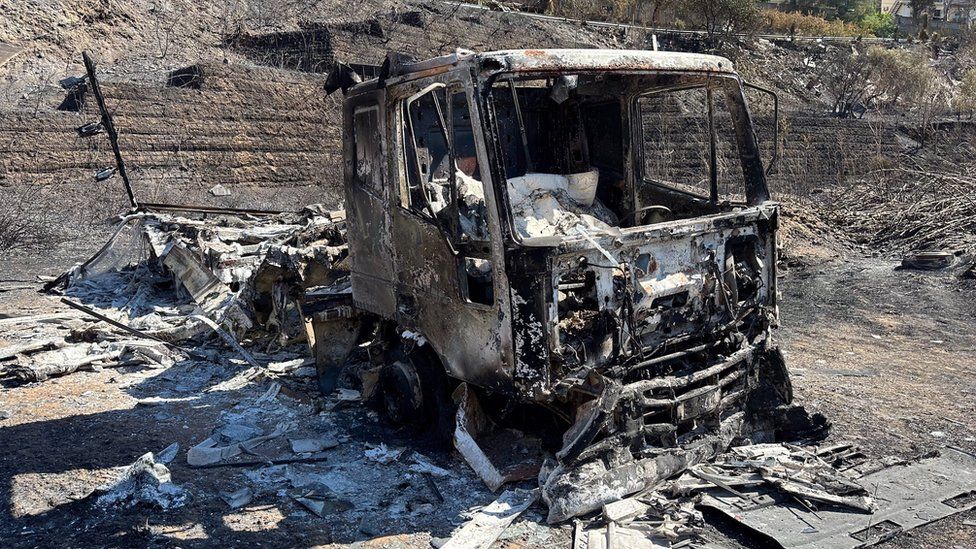Wildfires have been raging in parts of southern Italy recently – forcing thousands to flee. Many are blamed on arsonists.
Agricultural union Coldiretti suggests up to 60% of wildfires are man-made. But why would anybody provoke a deadly fire?
Locals in Calabria tell the BBC that everyone from clumsy farmers to feuding neighbours are to blame for the blazes.
The severe heat and drought, worsened by climate change, only make matters worse.
In this part of the Italy, wildfires do more than force evacuations and turn the ground to ash – they destroy the history and ecology of the land.
As we drive around the hills of central Calabria’s barren but spectacular Aspromonte National Park, charred remains of vehicles litter the side of the road.
In the last two years, fires have damaged a 13th century church in Sicily and burnt down several century-old olive trees in Puglia.
Most tragically, earlier this week, one of Calabria’s oldest folk musicians, 98-year-old Diego Aquilino, died in his bed when the flames reached his home.
The President of Calabria, Roberto Occhiuto, went even further than Coldiretti and estimated that arson in his region was behind 80% of wildfires.
“Last year in Calabria we caught 22 arsonists and this year, too, we are finding several,” Mr Occhiuto said.
He and regional authorities are keen to emphasise that they are putting systems in place to deter such behaviour – including drones that scan the territory for arsonists.
Nationwide legislation to combat arson also exists. In 2000, Italy introduced legislation barring anyone from building property on recently burnt terrain in order to combat arsonists looking to buy burnt out land for cheap.
Still, some man-made fires are not necessarily a result of criminal intent.
“We have images, for example, of farmers clumsily starting fires in an attempt to clear weeds,” Mr Occhiuto said. But he admitted that drones had also shown images of “organised arson squads”.
Every resident the BBC has spoken to in Calabria seems to have an idea of what lies behind intentional fires.
Some suspect firefighters spark the wildfires to force local authorities to pay attention to their plight and increase funding. Some suggest that tensions between rural neighbours are a key factor. Others blame shepherds who want to turn woodland into grazing land.
More still are convinced that pyromaniacs who want to spark chaos are the behind most blazes.

Giada Nicolo’s family home, which is built on a hillside in Mosorrofa in southern Calabria, almost burned down earlier this week after flames crept up from the valley, latched onto the ground floor and spread quickly to all three floors. She got her elderly relatives out just in time.
“All these fires are started by people,” she said. “Fires like these don’t start on their own. It’s arsonists, I’m absolutely convinced.”
“What they don’t realise is that they are hurting people, and putting lives at risk.”
The wildfires are a disaster for the surrounding environment, too.
Francesco Giardina of the Coldiretti tells the BBC it takes around 15 years for destroyed woodland to recover – and the area becomes more vulnerable to landslides.
Extreme temperatures and a lack of rainfall – which are serious issues in southern Italy and are linked to climate change – ensure that “petty pranks” turn into devastating blazes, he said.
A single spark can raze a huge area if the earth is parched. This week, Italian police arrested a 79-year-old man who allegedly lit a vast fire that destroyed 30 hectares (74 acres) of land – the equivalent of 42 football pitches – of olive groves in central Sicily.
“Spiteful or careless actions can result in serious, lasting hardship for the whole area,” said Mr Giardina.
He is right.
In Calabria, the smouldering evidence of arson is all around – now a permanent feature of a once-stunning landscape.
Related Topics
- Wildfires
- Climate change
- Italy
